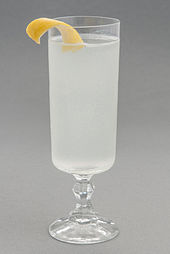Fizz

A fizz [ fɪs ] (plural: fizzes [ ˈfɪzɪs ], from English fizz [ fɪz ] = hiss, flare up) is a refreshing, alcoholic and carbonated cocktail . It is one of the classics in the history of cocktails and, with its numerous variants, forms its own drink group. The Gin Fizz is one of the most famous fizzes .
Basic structure
Fizzes are shaken sours that are topped up with a little soda water . The main ingredients are therefore the (usually named) base spirit , lemon juice, sugar or sugar syrup and soda. Additional ingredients can be added to round it off: A Silver Fizz also contains liquid egg white , a Golden Fizz egg yolk , a Royal Fizz a whole egg, and a Cream Fizz about 2 cl of cream. A gin fizz filled with champagne instead of soda is called a diamond fizz ; Sometimes, however, the addition Royal , which is common in other champagne drinks, is also used (cf. Kir ).
Difference Between Collins and Fizz
It is difficult to distinguish it from a Collins , as both drinks are soda-supplemented sours . Often the recipes are the same or only differ in details. The “official” recipes for a Gin Fizz and a John Collins from the International Bartenders Association differ, for example, in that the Gin Fizz is not “built” in the guest glass, but the sour mixture is shaken separately with ice and only then added to the guest glass Soda top up. In addition, it is served in a tumbler without ice cubes , whereas the Collins is served in a Collins or long drink glass filled with ice cubes.
Part is also differentiated by size: Sun Fizz is a only a "slightly aufgefizzter Sour", so rather an extended correspondingly little soda short drink that is served glass Fizz without ice cubes in a comparatively small. The Collins, on the other hand, is often seen as a real long drink, more soda is then used and served with ice cubes in a tall glass. However, this distinction is not uniform either; numerous contradicting statements can be made in the literature.
preparation
Fizzes are prepared on ice in a cocktail shaker and then poured through a strainer into a highball glass , which is 3/4 filled with ice cubes, or served without ice in a slightly smaller fizz glass or a small tumbler . Now a small shot of soda is “sprayed on”. If a siphon bottle is used, the characteristic and eponymous fizz sound is created. Since soda water has a higher content of sodium hydrogen carbonate , its reaction with citric acid creates additional carbon dioxide (CO 2 ) in the glass , an effect known from effervescent tablets . Alternatively, ordinary, highly carbonated mineral water can be used. A lemon wedge is suitable as a decoration, if at all. Fizzes are traditionally served and drunk without a straw.
The International Bartenders Association counts the Gin Fizz as an "unforgettable" classic ( The Unforgettables ) among their Official IBA Cocktails . In the recipe much soda is comparatively used: 4.5 cl gin , 3 cl freshly squeezed lemon juice and 1 cl sugar syrup are first shaken with ice cubes, then into a tumbler strained , with about 8 cl soda water filled and garnished with a slice of lemon, but without ice served. Another common formula consists of 5–6 cl gin, 3 cl lemon juice, 2 cl sugar syrup and a little soda.
Well-known Fizz variants

A fizz is possible with all spirits and liqueurs that go well in a sour . Examples are the Brandy Fizz with brandy as the base spirit, Rum Fizz with white rum , Sloe Gin Fizz with Sloe Gin (sloe liqueur) or as Royal Sloe Gin Fizz with an egg, Apricot Fizz with Apricot Brandy and a dash of orange juice, Danish Fizz with Gin and Cherry Brandy, Violet Fizz with Gin and Crème de Violette and the Pineapple Fizz with white rum and a dash of pineapple juice. The basic formula spirit (s) + citrus juice + sugar + soda is adapted to the ingredients used and supplemented if necessary; In the case of fizzes with liqueurs, for example, the sugar syrup is omitted or its proportion is reduced.
The Morning Glory Fizz in its form first published by George Kappeler in 1895 consists of scotch whiskey , lemon juice, sugar syrup, egg white and a little absinthe . In later versions, rye or bourbon whiskey are also used and the drink is rounded off with , for example, curacao , cognac and bitters .
A special feature is the in the 19th century in New Orleans resulting Ramos (Gin) Fizz gin, lemon juice, sugar syrup and egg white in addition, cream and a few drops of orange flower water , which is filled with little soda water.
Individual evidence
- ↑ Stephan Hinz : Cocktail Art - The Future of the Bar . Fackelträger Verlag, Cologne 2014, ISBN 978-3-7716-4553-3 , p. 308.
- ↑ Mornin ', Glory article on the Morning Glory Fizz with recipes (English language), Cocktailchronicles Mixology Monday, September 17, 2007, accessed on July 25, 2012.

